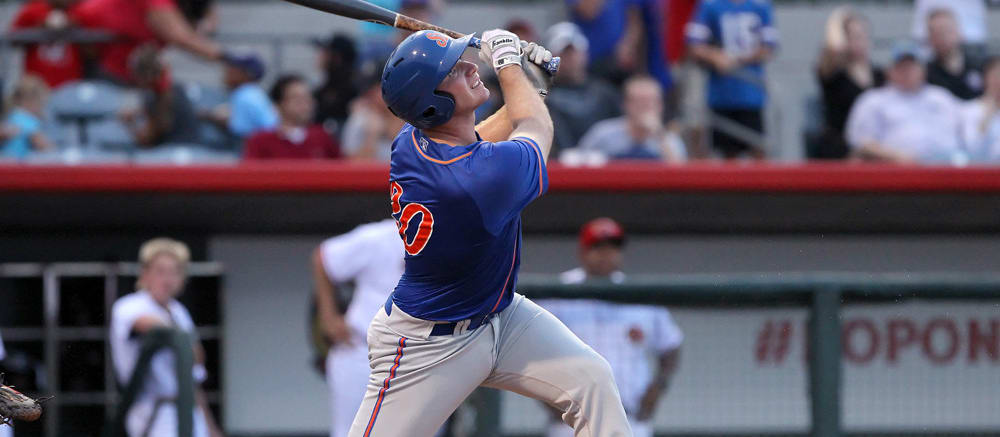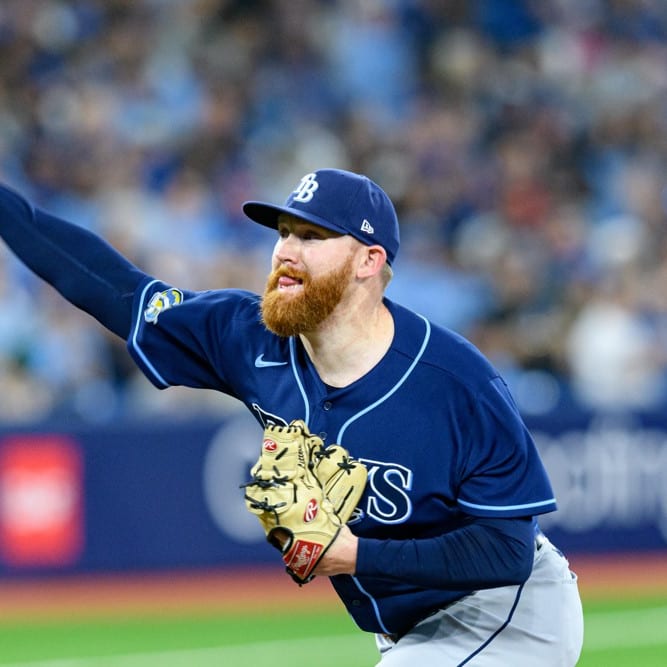This article is part of our Farm Futures series.
The bottom of the defensive spectrum is a dangerous place to be. The occasional prospect gets developed as a first baseman and profiles as a plus defender there, but most of the players who end up at first base or DH are there because they aren't good enough defensively to play anywhere else, yet their offensive production is so appealing that their team finds a spot for them.
The rule for first-base prospects is that they need to hit. They need to always hit, at every level of the minors. That doesn't mean being five or 10 percent better than league average. It means being at least 20 or 30 percent better if the player is young for the level, and at least 40 or 50 percent better if the player is at an age-appropriate level. This is not a place to preach patience. Often, these players come with a decent amount of swing-and-miss, which is fine as long as they also walk a lot. The best first-base prospects walk almost as much as they strike out.
I often reference when a player who may end up at first base bats and throws right-handed, because it puts even more pressure on the player's offensive output. Offensively, teams would prefer their first baseman to have the platoon advantage against righties, and defensively, left-handed first basemen are better suited to fielding balls hit in the hole between first and second, making throws to second or third, and holding runners on base. That's
The bottom of the defensive spectrum is a dangerous place to be. The occasional prospect gets developed as a first baseman and profiles as a plus defender there, but most of the players who end up at first base or DH are there because they aren't good enough defensively to play anywhere else, yet their offensive production is so appealing that their team finds a spot for them.
The rule for first-base prospects is that they need to hit. They need to always hit, at every level of the minors. That doesn't mean being five or 10 percent better than league average. It means being at least 20 or 30 percent better if the player is young for the level, and at least 40 or 50 percent better if the player is at an age-appropriate level. This is not a place to preach patience. Often, these players come with a decent amount of swing-and-miss, which is fine as long as they also walk a lot. The best first-base prospects walk almost as much as they strike out.
I often reference when a player who may end up at first base bats and throws right-handed, because it puts even more pressure on the player's offensive output. Offensively, teams would prefer their first baseman to have the platoon advantage against righties, and defensively, left-handed first basemen are better suited to fielding balls hit in the hole between first and second, making throws to second or third, and holding runners on base. That's not to say that most first basemen bat and throw left-handed, but righties seem to have to really force the issue to be given a shot. Consider how Jesus Aguilar, Jose Martinez and C.J. Cron did not get a good look as full-time players until their second organizations, and how Paul Goldschmidt and Rhys Hoskins were considered guilty until proven innocent by most outlets that rank prospects.
Here are the 2019 first base/DH prospect tiers:
TIER ONE
1. Yordan Alvarez, Astros
2. Peter Alonso, Mets
3. Nathaniel Lowe, Rays
This is the clear big three at the position. Alonso has the most power (all of these players have at least 65-grade raw power), and Alvarez has the best hit tool. Alvarez has played some outfield, but ideally he will play a combination of first base and designated hitter when he joins Houston, as he is a below-average defender in the outfield. Alonso is a poor defender at first base, but he has answered the bell offensively, and should do enough damage with the bat for the Mets to put up with his defensive shortcomings. Like Alvarez, Lowe figures to split time between first base and designated hitter when he joins the big-league club. We should see all of these guys in the majors this year, with the order of debut likely to be: Alonso, Lowe, Alvarez (Alvarez is two years younger than the other two).
TIER TWO
4. Nick Pratto, Royals
5. Tyler Nevin, Rockies
Pratto was excellent in the second half last year, and while he has struck out more than expected in pro ball, I think he will gradually improve on that mark during his march to Kansas City. Even while his power production is a bit ahead of schedule, that home ballpark would probably limit him to 20-to-25 homer production early on. Nevin had a breakout 2018 that was capped by him dominating in the Arizona Fall League, which vaulted him into the top 100. He has more trade value than Pratto in many leagues, as it's easy to dream on a first baseman with a plus hit tool calling Coors Field home, but the Rockies have made a living out of blocking prospects of his caliber, so it is far from a forgone conclusion that he will someday be the everyday guy.
TIER THREE
6. Alec Bohm, Phillies
7. Grant Lavigne, Rockies
8. Seth Beer, Astros
9. Christin Stewart, Tigers
10. Malcom Nunez, Cardinals
11. Evan White, Mariners
Bohm (6-foot-5, 225 pounds) is currently playing third base, but I think he eventually ends up at first. Lavigne vs. Bohm is pretty fascinating. Their raw tools are pretty similar, but Bohm was drafted out of college with the No. 3 overall pick while Lavigne was drafted out of high school, from a school in the northeast (New Hampshire) no less, with the No. 42 overall pick. Obviously if we go on small-sample performance, Lavigne gets the big edge, but pre-draft pedigree points to Bohm. Beer is currently being developed as a corner outfielder, but he would be a statue out there, so he probably ends up getting the majority of his playing time at designated hitter. Even with his defensive limitations, Beer may hit enough to play every day. Stewart is a clear designated hitter long term, but he may retain outfield eligibility amid the Tigers' rebuild. Nunez is a wild card, as he played third base in the Dominican Summer League, but also saw time at first base, and as a 17-year-old who already measures in at 5-foot-11, 205 pounds, we may be dealing with a Willie Calhoun type of situation down the road, where the glove doesn't profile anywhere. White is easily the best defender of the 21 tiered players, but his offensive upside is debatable. He will head to Double-A for his age-23 season, and if he struggles at all at the plate, his stock will take a hit.
TIER FOUR
12. Ryan Noda, Blue Jays
13. Miguel Vargas, Dodgers
14. Matt Thaiss, Angels
15. Josh Naylor, Padres
16. Triston Casas, Red Sox
17. Daniel Vogelbach, Mariners
18. Tyreque Reed, Rangers
19. Jhailyn Ortiz, Phillies
20. Joe McCarthy, Rays
21. Brent Rooker, Twins
Based on what he did at Low-A, Noda appears to have all the tools to be a three-true-outcomes force, but at his age (turns 23 in March), he will face skepticism until he has success in the majors. The Dodgers won't move Vargas from third base to first base until they absolutely have to, but his body is already pretty stiff at the hot corner. Thaiss and McCarthy are knocking on the door of the majors but may struggle to hit enough to profile at the bottom of the defensive spectrum. Naylor saw time in left field last year, and was predictably pretty bad out there. The Padres have too many outfielders and too many first basemen ahead of Naylor on the organizational depth chart, but it also seems unlikely that they would get much for him in a trade (recall that the Cubs only got Mike Montgomery for Vogelbach), so his future is very hazy. Casas is another current third baseman I expect to end up at first base when it's all said and done. He offers big power but projects to strike out a ton. Vogelbach is somehow still prospect eligible despite being 26 years old. This is the case because he is a horrific defender and the Mariners had been employing Nelson Cruz. He may get a chance to prove he can handle the strong side of a platoon this year. Reed and Ortiz are big and powerful, but the smart money is on them both failing to hit enough to be everyday players. Rooker is old and similarly bad in the outfield and at first base, but given the Twins' organizational depth chart, I expect him to debut as a 1B/DH.
Honorable Mentions: Bobby Bradley (CLE), Gavin Sheets (CHW), Cristian Santana (LAD), Dermis Garcia (NYY), Pavin Smith (ARI), Edwin Rios (LAD), Luken Baker (STL), Rowdy Tellez (TOR), Luke Raley (MIN), Lewin Diaz (MIN)










